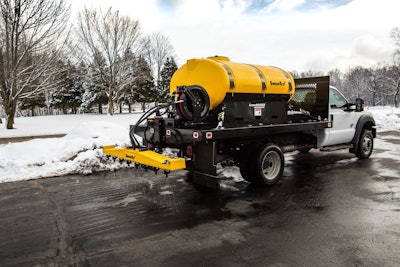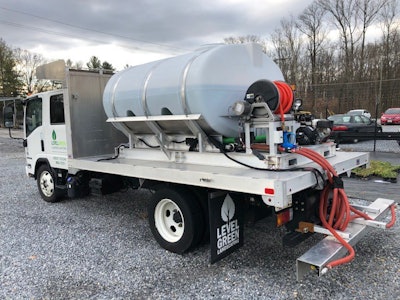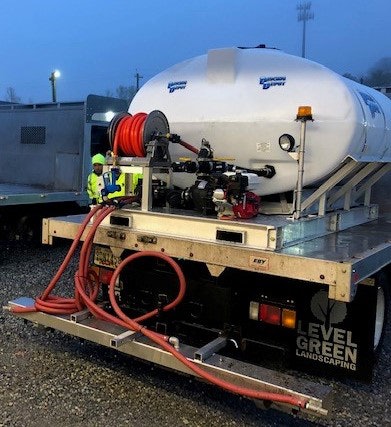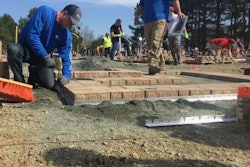 Photo: SnowEx
Photo: SnowExUsing brine as part of your snow removal services is nothing new, but it is becoming more widely adopted, so here’s what you should know about this material and how it can help boost your efficiency.

Pros and cons of brine
One of the most useful benefits of brine is it allows landscape contractors to be proactive and perform anti-icing before precipitation occurs. This helps prevent snow from bonding to the pavement.
“Preventing a bond is critical,” says Brian Birch, COO of the Snow & Ice Management Association (SIMA). “You get better coverage of a property or a surface with liquid. You have a bit more control over the liquid to a degree, depending on the equipment you use. If you’re using a spreader that’s flinging salt, you have to deal with this concept of bounce and scatter.”
Birch says that brine can be applied for a period of time before the storm and still be effective.
“You have a service you can offer your customers where you’re treating their pavement before the first snowflake ever falls,” says Rick Kier, founder of Pro Scapes, based in Syracuse, New York. “So, you’re very proactive and the customers appreciate that. It’s a strong selling point. It also puts you on the cutting edge of the industry, as most contractors do not offer liquids and brine in particular.”
Some areas where brine can be ideal are areas such as sidewalks, low-tolerance accounts or sections that need constant bare pavement and high traffic areas, says Birch.
“A great place to start is sidewalks,” Birch says. “You get a double benefit there because sidewalks are smaller; they’re easier to control. Not as much product is needed, so it’s less risky to start off with and being proactive and keeping it free from snow and ice is a great way to manage your sidewalks anyway.”
Greg Stacho, snow manager for Level Green Landscaping based in Upper Marlboro, Maryland, says that by using brine you can reduce your salt costs and there are fewer salt chlorides running into rivers and streams.
 Photo: Level Green Landscaping
Photo: Level Green Landscaping“Where we apply is where it stays, no bouncing off walks or asphalt areas,” Stacho says.
The reduction of granular salt usage also means there’s no visible residue left after a storm, meaning customers won’t have to worry about tracking salt into buildings.
“There’s a big business case for it long-term both in customer service and level of service outcomes for the site and in cost savings by using less material,” Birch says.
As for the cons of using brine, this comes down more to the specific conditions where it should not be used rather than any true negatives about the product.
“The key with using liquids is there’s probably a bigger learning curve and more knowledge required to use them and know when not to use them,” Birch says.
Properties where applying brine can be a challenge include surfaces such as permeable pavers. SIMA offers more advice on controlling snow and ice on these types of hardscapes here. Birch says hilly or sloped sites can also be harder to treat, as the brine can run off the site.
Some of the conditions where salt brine should not be used include when the ground temperatures are too cold for it to be effective or when rain is forecasted prior to the snow event, as this would dilute the solution and make it less effective.
Kier says you also shouldn’t use brine when it’s really windy out, as it has a tendency to freeze.
“You do have to be very careful with brine because if you don’t use it properly, you can actually make the parking lot icy,” Kier says. “As opposed to eliminating the risk of slip and fall, you’re now creating that risk.”
Stacho says landscapers will need to buy specific spray equipment and storage tanks if they want to start using brine, so those costs are something to keep in mind.
One challenge that can occur is educating clients on the fact that just because they can’t see the layer of brine doesn’t mean it isn’t working.
Misconceptions and mistakes with brine
One misconception about brine is that it has to be an expensive endeavor and is only suitable for larger companies. Birch says there’s a kernel of truth to that, as adding on liquids is an investment, but even smaller companies can take advantage of using brines on the job site.
 Photo: Level Green Landscaping
Photo: Level Green Landscaping“I think anyone who’s approaching it has to be thoughtful and educate themselves,” Birch says.
A major fallacy surrounding brine is the belief that it completely replaces a granular salt program.
“Brine is not a magic bullet,” Kier says. “It’s not going to be a replacement for rock salt. It’s just one more tool in the toolbox. You need to know when you can use it when you can’t use it.”
Stacho says another misunderstanding of brine is that it doesn’t work. However, this is typically due to the applicator not knowing which scenarios brine is ineffective in and assuming it doesn’t work at all.
Another issue that can occur is when landscapers try to upsell applying brine as a premium service.
“The contractors who have been successful position it as a tool in the toolbox to help manage the desired level of service for the customer and really focused on being that expert practitioner versus some kind of premium liquid service deal,” Birch says.
Birch says a common mistake is trying to build your own application equipment, which can cause issues.
“There are commercial grade liquid application systems that fit on pickup trucks and they exist for a reason,” Birch says. “They’re built well. You can control and have consistent pressure. You have quality pumps and all the components of the spray system are built to work together.”
Birch says there are people who are successful with building their own application equipment, but the key is to do the research first and to have a properly sized pump for the equipment.
Check back tomorrow for part two where we’ll look at the best practices when it comes to applying brine and when you should consider making your own salt brine.











